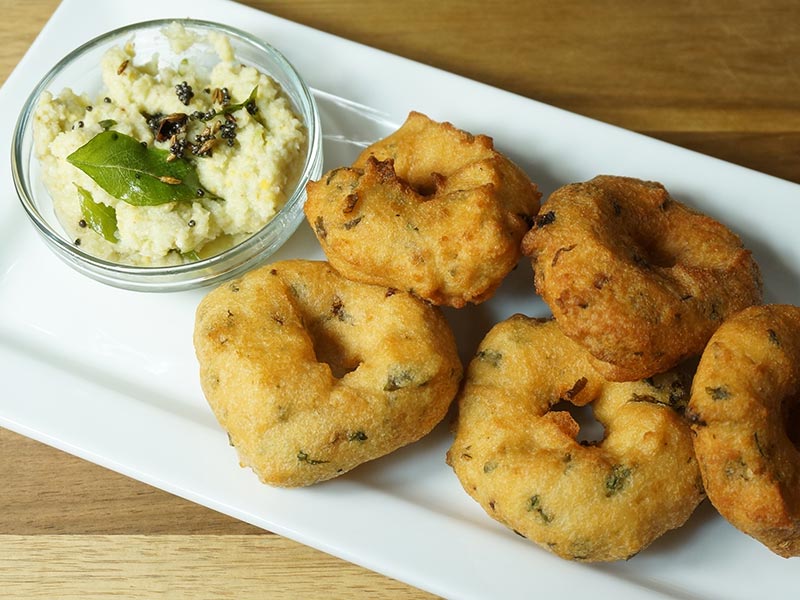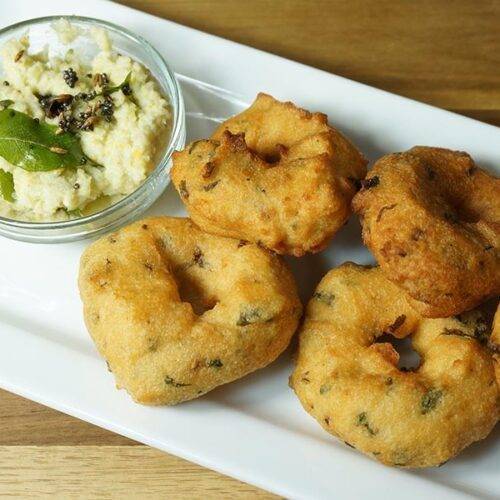Medu Vada
Ingredients
- 1 cup split washed urad dal (available in Indian stores)
- 1/8 teaspoon asafetida (hing)
- 2 teaspoon whole coriander seeds (sabut dhania)
- 1 tablespoon green chili chopped
- 2 tablespoons cilantro chopped (hara dhania)
- 1 teaspoon salt
- Oil to fry
Instructions
- Wash and soak dal in about 3 cups of water for about 4-6 hours.
- Drain the water and grind dal to smooth paste using very little water just enough to grind, food processor works good for this. Blend for another 2 minutes to whip dal to make fluffy. Take dal batter out in a wide bowl.
- Add all the ingredients to the dal batter, cilantro, green chili, coriander, asafetida and salt, beat the batter for 2-3 minutes this will make the batter light and fluffy. To make sure batter is ready put one drop of batter in a bowl of water, batter should float.
- Keeping the right consistency of batter is very important; add water as needed batter should not be soft but not runny. When you put the batter on your palm batter should hold its shape. Make the Vadas batter when you are ready to fry them, as the batter sit will get soft if you are not ready to fry keep batter refrigerated.
- Heat the oil in a frying pan over medium high heat.
- The frying pan should have about 1 inch of oil. To check if the oil is ready, put one drop of batter in oil. The batter should sizzle and come up but not change color right away. If oil is very hot Vadas will not cook through and will not be crispy.
- Wet the palms and take golf size batter and place over your palm, flatten to round shape and make hole in the center looking like donut now with other hand wet fingers slowly slide Vada into the hot oil.
- Fry the Vadas from both sides to golden brown. Take them out over a paper towel to drain access oil.
- Traditionally Medu Vada is served with Coconut Chutney, and sambar (aromatic lentil soup with vegetables).
Notes
- If the Medu Vada Batter is too thick: The Vada will shape nicely but they will be hard inside after frying.
- If the batter is too soft: it will not be able to hold the shape and will absorb too much oil.
- It’s the consistency of the batter that determines how soft and shapely the Vadas turn out.
Medu Vada: A South Indian Delicacy
Medu Vada is a South Indian delicacy often served as an appetizer or snack, especially during festive occasions like Yugadi. It is a gluten-free and vegan dish made primarily from urad dal (black gram lentils) batter, seasoned with spices like cumin seeds, black pepper, and curry leaves. The batter is shaped into round doughnuts and deep-fried until golden brown, resulting in a crispy exterior and a soft, fluffy interior.
Medu Vada is commonly enjoyed with coconut chutney or sambar, enhancing its flavor profile and making it a popular choice for those seeking gluten-free and vegan snack options. Medu Vada is a popular South Indian snack known for its crispy exterior and soft interior texture. Originating from the state of Tamil Nadu, it has gained widespread popularity across India and beyond. This medu vada recipe offers a step-by-step guide on how to make this delectable treat right in your kitchen.
How to Make Medu Vada: Step-by-Step Recipe
Preparing the Batter
To start making medu vada, you’ll need to prepare the batter first. Begin by soaking urad dal in water for at least 4-5 hours or preferably overnight. The soaked dal should be soft enough to easily break when pressed between your fingers. Once soaked, drain the water and transfer the dal to a blender. Grind it to a smooth paste, adding minimal water as needed. The consistency should be thick, similar to that of a pancake batter. This step is crucial in achieving the perfect texture for your medu vada.
Shaping the Vadas
Once the batter is ready, transfer it to a mixing bowl. Add finely chopped green chilies, ginger, curry leaves, cumin seeds, asafoetida, and salt to taste. Mix all the ingredients thoroughly to ensure an even distribution of flavors. Now, heat oil in a deep frying pan or kadhai on medium heat. To shape the vadas, wet your palms with water to prevent sticking. Take a small portion of the batter and flatten it slightly to form a disc shape with a hole in the center, resembling a donut. Carefully slide the shaped vada into the hot oil and fry until golden brown and crispy on both sides. Repeat the process with the remaining batter, frying a few vadas at a time to avoid overcrowding the pan.
Frying to Perfection
Achieving the perfect medu vada requires frying them to crispy perfection. Make sure the oil is adequately heated before adding the vadas to ensure they cook evenly and develop a crunchy exterior. It’s essential to maintain the oil at a consistent temperature throughout the frying process. Avoid overcrowding the pan, as this can lower the oil temperature and result in soggy vadas. Fry the vadas in small batches, flipping them occasionally to ensure uniform browning on all sides. Once done, remove the vadas from the oil using a slotted spoon and drain the excess oil on paper towels.
Serving Suggestions
Medu vada is best enjoyed hot and crispy, served with coconut chutney and sambar. You can also pair it with a tangy tomato chutney or spicy mint chutney for added flavor. Some prefer to enjoy medu vada with a cup of hot filter coffee, making it a perfect breakfast or evening snack option. Experiment with different dipping sauces and accompaniments to find your favorite combination.
Tips for Making Perfect Medu Vada
- Ensure the urad dal is soaked well to achieve a smooth batter texture.
- Maintain the oil temperature while frying to achieve crispy vadas.
- Wet your palms with water to prevent the batter from sticking while shaping the vadas.
- Add chopped green chilies and ginger for an extra kick of flavor.
- Serve medu vada hot for the best taste and texture.
Variations of Medu Vada
While the traditional medu vada recipe calls for basic ingredients like urad dal, spices, and herbs, you can experiment with variations to suit your taste preferences. Some popular variations include:
- Masala Medu Vada: Add coriander leaves and grated carrots to the batter for an extra burst of flavor.
- Rava Medu Vada: Mix semolina (rava) with the urad dal batter to add a crunchy texture to the vadas.
- Vegetable Medu Vada: Incorporate grated vegetables like carrots, cabbage, and spinach into the batter for a nutritious twist.
- Cheese Medu Vada: Stuff the vadas with a cheesy filling or sprinkle grated cheese on top before frying for a gooey, indulgent treat.
Benefits of Medu Vada
Medu vada is not only delicious but also offers several health benefits when consumed in moderation. Here are some of the benefits:
- Rich in Protein: Urad dal, the main ingredient in medu vada, is a good source of protein, essential for muscle repair and growth.
- Nutrient-Dense: It contains essential nutrients like iron, magnesium, and potassium, which are vital for overall health and well-being.
- Gluten-Free: Since medu vada is made from urad dal, it is naturally gluten-free, making it suitable for individuals with gluten sensitivities or celiac disease.
- Good Source of Fiber: Including medu vada in your diet can help improve digestion and promote gut health due to its fiber content.
- Energizing Snack: It provides a quick energy boost, making it an ideal snack option for busy days or post-workout refueling.
FAQs about Medu Vada
Q: Can I make the batter ahead of time?
A: Yes, you can soak the urad dal and grind the batter ahead of time. Store it in the refrigerator for up to 1-2 days and fry the vadas when ready to serve.
Q: Can I freeze the vadas?
A: While it’s best to consume medu vada fresh for optimal taste and texture, you can freeze the shaped vadas and fry them directly from frozen when needed. However, freshly fried vadas are recommended for the best flavor.
Q: Can I bake instead of frying?
A: While traditional medu vada is deep-fried for that crispy texture, you can try baking them in a preheated oven at 375°F (190°C) for 20-25 minutes or until golden brown for a healthier alternative.
Q: Can I use split urad dal instead of whole urad dal?
A: Yes, you can use split urad dal (white or black) to make medu vada. However, the texture may vary slightly compared to using whole urad dal.
Q: Can I make gluten-free medu vada?
A: Yes, medu vada is naturally gluten-free since it’s made from urad dal. Just ensure that all ingredients used are gluten-free, especially if adding any additional flavorings or seasonings.
Explore more Indian recipes on Manjula’s Kitchen:
In conclusion, medu vada is a versatile and flavorful snack that can be enjoyed on its own or paired with a variety of chutneys and dips. With this detailed recipe and helpful tips, you can recreate this South Indian delicacy at home and impress your family and friends with your culinary skills. So, roll up your sleeves, gather your ingredients, and get ready to savor the crispy goodness of homemade medu vada!


Leave a Reply
You must be logged in to post a comment.